Mobile App Testing Checklist: Essential Tips for 2025
July 12, 2025

In the fast-paced world of mobile apps, a single bug can mean the difference between a five-star review and a quick uninstall. For developers, especially those leveraging powerful toolkits like NextNative to build cross-platform applications with familiar web technologies, the final hurdle before launch is a rigorous quality assurance (QA) process. But with so many variables, where do you even begin? A comprehensive mobile app testing checklist is your most critical asset.
This isn't just a simple to-do list; it's a strategic roadmap ensuring every user interaction is smooth, every feature works flawlessly, and your app is secure and performant across the diverse landscape of target devices. A great checklist prevents critical oversights, standardizes your testing efforts, and ultimately saves you time, money, and post-launch headaches. It transforms a potentially chaotic process into a structured, repeatable system for success.
This guide cuts through the noise to bring you a curated roundup of the seven best checklists, platforms, and testing resources available today. We are diving straight into the tools that will help you ship high-quality NextNative apps that delight users and stand out in a crowded marketplace. For each resource, we’ll provide a clear overview, actionable insights, screenshots, and direct links to help you find the perfect fit for your workflow. Let's get your app ready for a flawless launch.
1. Your Checklists: The Versatile Project Management Companion#
Kicking off our list is a resource that shines because of its practicality and seamless integration into your existing workflow. Your Checklists offers a robust, free mobile app testing checklist designed to be more than just a static document; it's a dynamic tool built for action. It covers the essential pillars of mobile QA, from initial functionality and performance stress tests to intricate security checks and final app store submission readiness.
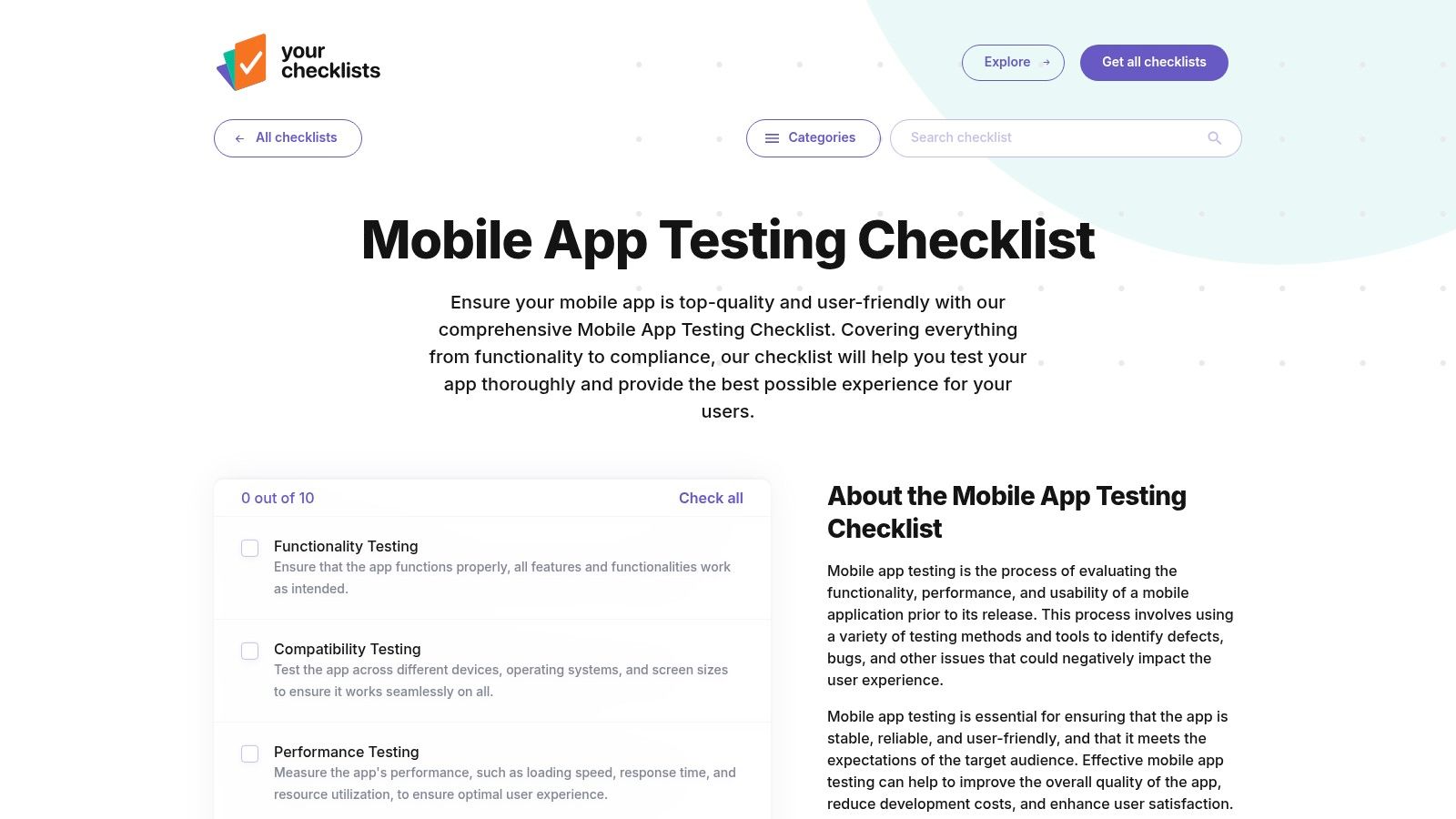
The platform’s standout feature is its bridge between QA planning and project execution. Instead of just giving you a list to print, it provides clear, step-by-step guides on how to import and use the checklist directly within popular project management tools like Trello, Asana, and Jira. For NextNative developers, this means you can embed quality assurance tasks directly into your sprints, making QA a continuous, visible part of the development cycle rather than an afterthought.
Key Features and User Experience#
The user interface is clean, straightforward, and easy to navigate. You can access the core mobile app testing checklist without any cost or registration, which is a huge plus for teams wanting to get started immediately.
- Project Management Integration: This is the core differentiator. By turning checklist items into actionable cards or tasks in Trello, Asana, or Jira, you create a single source of truth for your team.
- Comprehensive Coverage: The checklist is thorough, covering areas often overlooked in basic lists, such as battery consumption, offline functionality, and app store metadata compliance.
- Specialized Bundles: While the main checklist is free, Your Checklists also offers paid bundles for specific industries (e.g., FinTech, Healthcare) which come with more niche, compliance-focused testing points.
- User-Friendly Access: No mandatory sign-up to view the primary checklist makes it incredibly accessible for a quick review or for teams on a tight budget.
Pro Tip: When integrating with a tool like Jira, use the guide to create a dedicated "QA" issue type. You can then use the checklist items to generate sub-tasks for each user story, ensuring every new feature undergoes a standardized testing process. For a deeper dive into establishing these processes, explore these insights on mobile app quality assurance.
Pros and Cons#
| Pros | Cons |
|---|---|
| ✅ Free access to the comprehensive core checklist. | ❌ Limited customization options for the free checklist. |
| ✅ Excellent integration guides for Trello, Asana, & Jira. | ❌ Specialized industry checklists are a paid extra. |
| ✅ Clean, user-friendly interface with no clutter. |
Overall, Your Checklists is an exceptional starting point for any NextNative developer or startup looking to systematize their QA process. It excels at making your mobile app testing checklist an active, integrated part of your project management, fostering a culture of quality from day one.
Website: Your Checklists Mobile App Testing Checklist
2. BrowserStack: The Real-Device Testing Powerhouse#
Next up is a platform that moves beyond theoretical lists and into the real world of device fragmentation. BrowserStack offers an incredibly detailed mobile app testing checklist that directly addresses the complex challenges of modern development. More than just a guide, it serves as a gateway to their powerful cloud-based testing infrastructure, allowing you to execute every checklist item on thousands of real mobile devices.
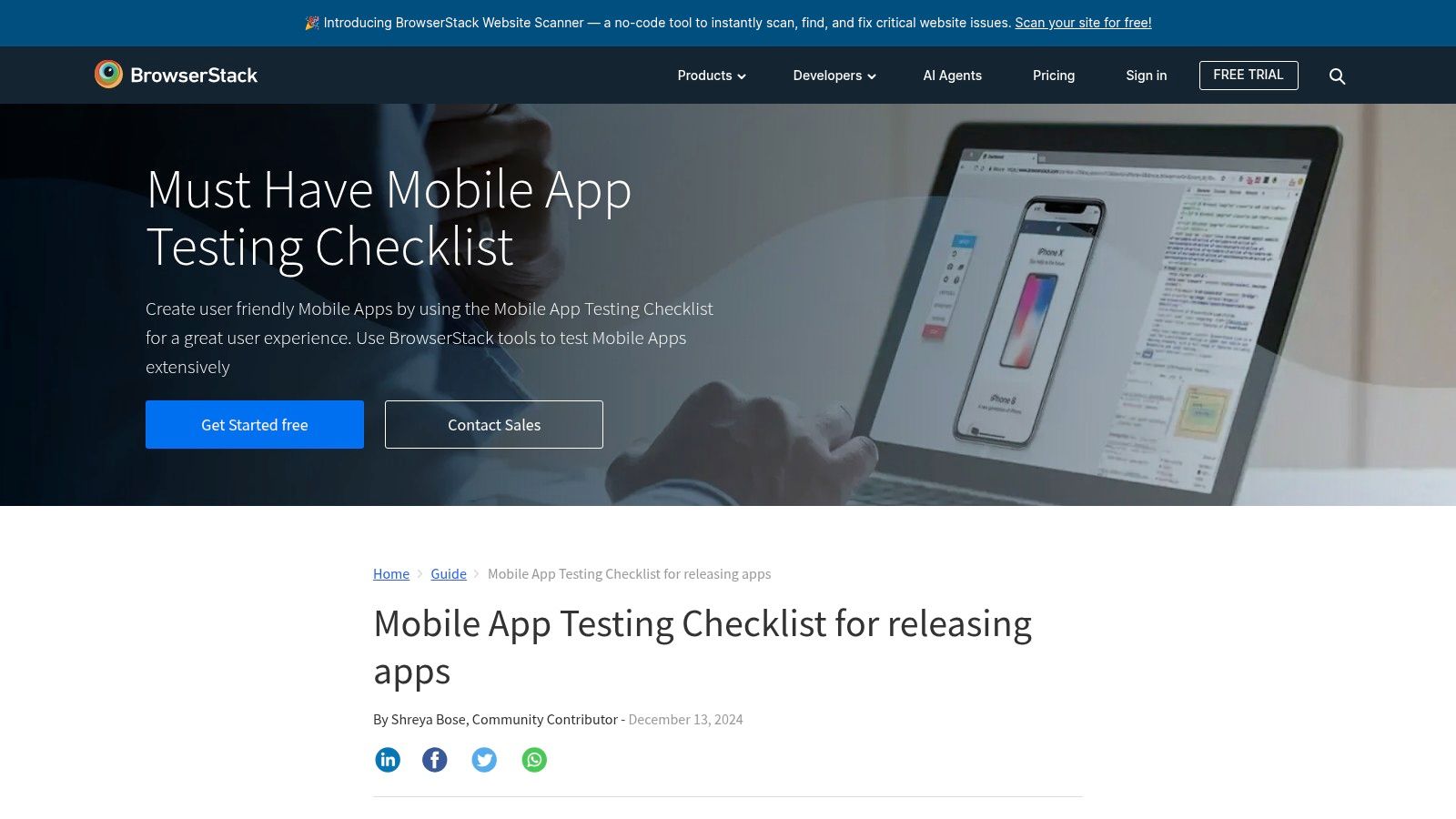
The primary advantage of BrowserStack is its seamless integration of theory and practice. You can read about the importance of testing on different screen sizes and OS versions, and then immediately launch a live session on that exact device combination using their App Live feature. This makes it an end-to-end solution for NextNative developers who need to ensure their application not only works but delivers a flawless user experience across a vast, unpredictable device landscape.
Key Features and User Experience#
BrowserStack's platform is built for serious QA. The interface is professional and packed with features, yet remains intuitive enough for teams to get started quickly. While the checklist itself is a free, valuable resource, the real power is unlocked when paired with their testing suite.
- Real Device Cloud: This is BrowserStack's crown jewel. Gain instant access to a massive inventory of real iOS and Android devices for manual (App Live) and automated (App Automate) testing.
- Comprehensive Checklist: Their guide is exhaustive, covering functionality, performance, security, localization, and network condition testing. It’s an educational resource in its own right.
- Automated Testing Integration: Easily run your Appium, Espresso, or XCUITest scripts across hundreds of devices in parallel, drastically reducing test cycle times.
- Cross-Platform Support: Perfect for NextNative developers, it provides robust support for testing both iOS and Android builds from a single platform.
Pro Tip: Use BrowserStack's network simulation feature to test how your app behaves on slow or unstable connections (e.g., "spotty 3G"). This is critical for validating loading states, offline functionality, and data-caching mechanisms, which are key components of a positive user experience. For a deeper look at how this impacts users, explore these best practices for mobile app usability testing.
Pros and Cons#
| Pros | Cons |
|---|---|
| ✅ Access to thousands of real iOS and Android devices for testing. | ❌ Advanced tools and extensive testing require a paid plan. |
| ✅ Excellent resource for both manual and automated QA. | ❌ Can have a steeper learning curve for complete beginners. |
| ✅ Detailed checklist serves as a great educational tool. |
In summary, BrowserStack is the go-to choice for teams that need to validate their app's performance in real-world conditions. While the free checklist is a fantastic starting point, the platform's true value lies in providing the tools to execute that mobile app testing checklist with unparalleled accuracy and scale.
Website: BrowserStack Mobile App Testing Checklist
3. Ubertesters: Bridging the Gap Between Checklist and Execution#
Next up is Ubertesters, a platform that provides not just a comprehensive mobile app testing checklist, but also a full-fledged ecosystem to manage your entire QA process. It stands out by combining a static, downloadable resource with a dynamic, collaborative platform, offering a solution for teams at every stage of their testing maturity. Their detailed guide covers critical areas like device compatibility, network conditions, UI/UX consistency, core app functionality, and app store readiness.
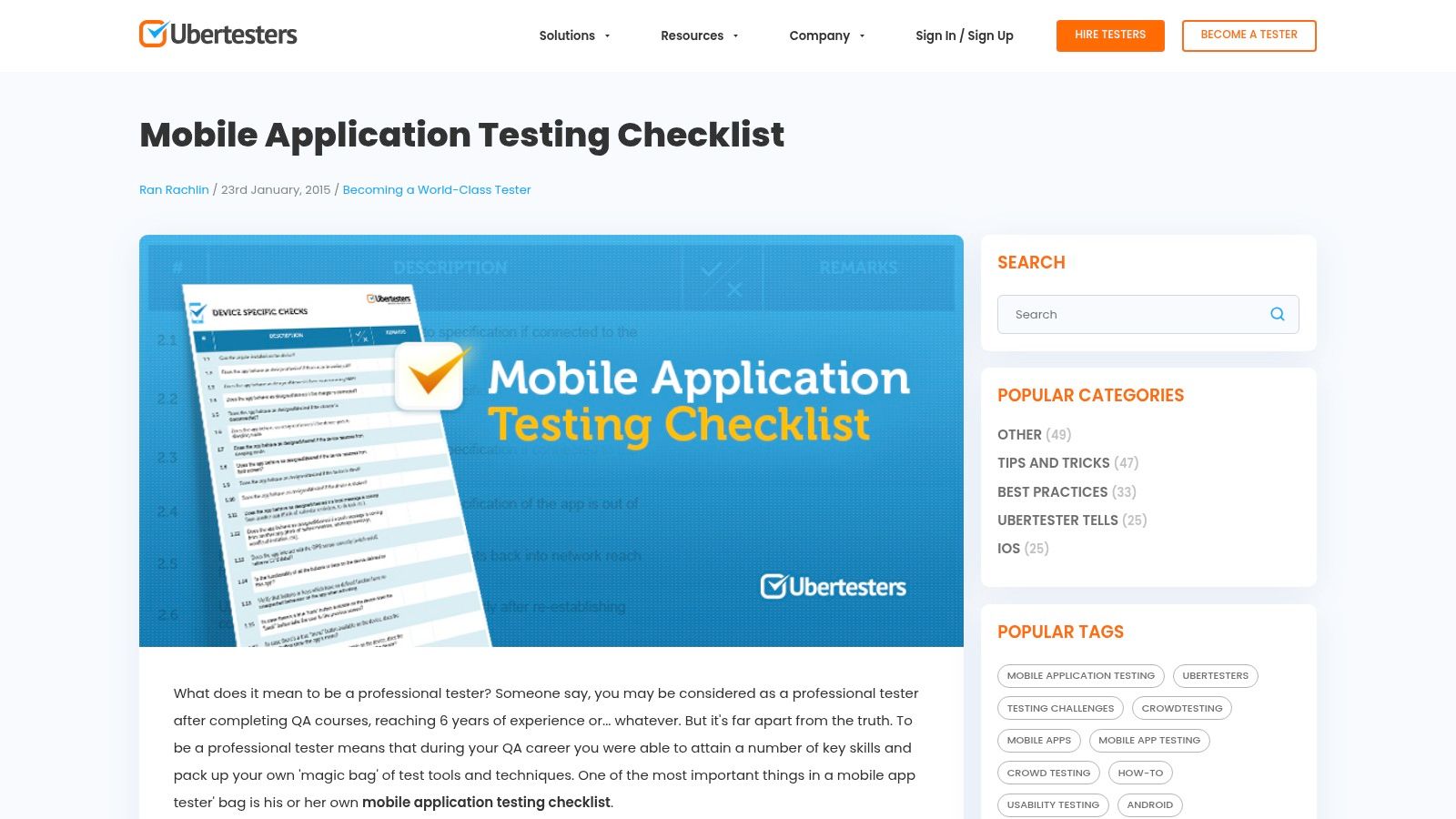
What makes Ubertesters particularly powerful for NextNative developers is this dual approach. You can start with their free, downloadable PDF checklist to quickly structure your initial testing sprints. As your project scales, you can transition to their integrated platform, which supports beta testing, real-time bug reporting, and collaborative workflows. This progression allows you to build a robust QA framework without having to switch tools mid-project, ensuring consistency from MVP to a full-scale launch.
Key Features and User Experience#
Ubertesters’ offerings are designed to streamline the often-chaotic process of mobile QA. The free checklist is clearly organized and easy to follow, making it a great educational resource as well as a practical tool.
- Comprehensive Checklist: The checklist is meticulously broken down into logical categories, covering everything from basic installation tests to complex scenarios involving interruptions like calls or low battery.
- Downloadable PDF: The availability of a PDF version is a simple but highly practical feature, allowing for offline access and easy sharing among team members or stakeholders who aren't on the platform.
- Integrated QA Platform: Beyond the checklist, Ubertesters offers a suite of tools for test management, over-the-air (OTA) build distribution, and in-app bug reporting, creating a closed-loop system for quality assurance.
- Team Collaboration Tools: The platform is built for collaboration, enabling testers, developers, and project managers to communicate effectively on bug reports and test cases.
Pro Tip: Use the Ubertesters checklist to define your baseline test cases. Pay special attention to the "Store" section, which outlines requirements for metadata, screenshots, and descriptions. This can prevent last-minute rejections from the Apple App Store or Google Play. To further bulletproof your app, consider integrating key security protocols; you can explore a guide on mobile app security best practices to get started.
Pros and Cons#
| Pros | Cons |
|---|---|
| ✅ Free, detailed, and downloadable checklist. | ❌ Advanced platform features require registration or a plan. |
| ✅ Provides a full suite of QA and beta testing management tools. | ❌ The platform may have a steeper learning curve than a simple checklist. |
| ✅ Excellent for scaling from a simple checklist to a full QA platform. |
In summary, Ubertesters is an ideal choice for teams looking for a scalable solution. It serves both the developer needing a quick, reliable mobile app testing checklist and the enterprise requiring a powerful, collaborative platform to manage complex QA cycles.
Website: Ubertesters Mobile Application Testing Checklist
4. QAwerk: The Professional QA Partner and Resource Hub#
For teams that need more than just a list, QAwerk offers a dual-value proposition: a comprehensive, free mobile app testing checklist and a direct line to professional QA services. This platform is ideal for NextNative developers who want a detailed guide for their internal teams but also need the option to bring in expert testers for more intensive, specialized quality assurance. The checklist is structured to guide you from early documentation review all the way through to beta testing and final launch preparations.
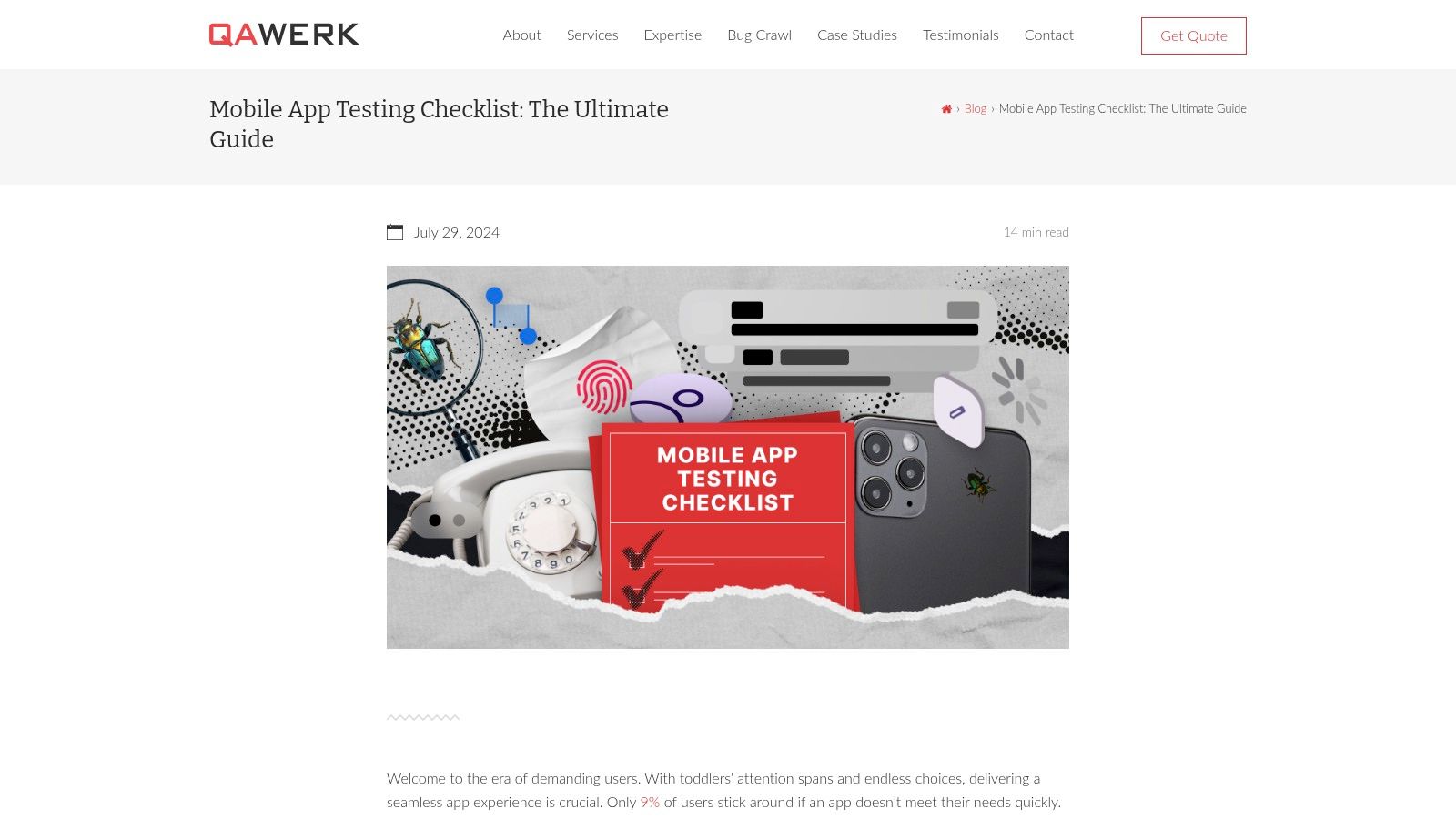
What sets QAwerk apart is its seamless integration of educational resources with professional services. You can use their detailed checklist to build a robust internal QA process, covering crucial areas like functional, usability, performance, and security testing. Then, if you hit a bottleneck or need to scale your testing efforts for a major release, you can engage their team for manual or automated testing support, ensuring no stone is left unturned.
Key Features and User Experience#
The QAwerk blog post housing the checklist is well-organized and serves as a powerful educational tool. It breaks down the entire testing lifecycle into logical phases, making it easy for developers to understand what to test and when.
- Holistic Testing Framework: The checklist is segmented into distinct stages, including documentation review, functional testing, UI/UX validation, performance benchmarks, and security vulnerability checks.
- Actionable and Explanatory: Each checklist item is not just a to-do point; it often comes with a brief explanation of why it's important, adding valuable context for junior developers or teams new to mobile QA.
- Path to Professional Services: The platform provides a clear pathway from self-service QA (using the checklist) to professional QA assistance. This is perfect for startups that may start with DIY testing but plan to hire experts as they grow.
- Focus on Early-Stage Quality: The checklist strongly emphasizes initial documentation and requirements testing, helping teams catch logical flaws and inconsistencies before a single line of code is written.
Pro Tip: Use the "Usability Testing" section of the QAwerk checklist as a script for your user feedback sessions. Ask real users to perform the tasks listed, such as navigating the app, completing the onboarding flow, and interacting with core features. This transforms a simple checklist into a powerful user research tool.
Pros and Cons#
| Pros | Cons |
|---|---|
| ✅ Highly detailed, structured checklist covering the full lifecycle. | ❌ Professional QA services come with additional costs. |
| ✅ Serves as both a self-help resource and a gateway to expert help. | ❌ The checklist is a static resource (a blog post), not a dynamic tool. |
| ✅ Strong focus on catching issues early in development. |
QAwerk is a fantastic resource for teams looking for a structured approach backed by the option of professional support. It empowers NextNative developers to implement a thorough internal mobile app testing checklist while providing a safety net of expert services for when testing demands exceed internal capacity.
Website: QAwerk Mobile App Testing Checklist
5. Process Street: The Workflow-Powered QA Engine#
Next up is a platform that transforms a simple checklist into a powerful, repeatable workflow engine. Process Street provides a comprehensive Mobile App Quality Assurance Checklist designed not just for one-time use, but for standardizing your entire QA operation. It methodically guides your team through every critical stage, from identifying target devices and setting up test environments to executing detailed manual tests and verifying security protocols.
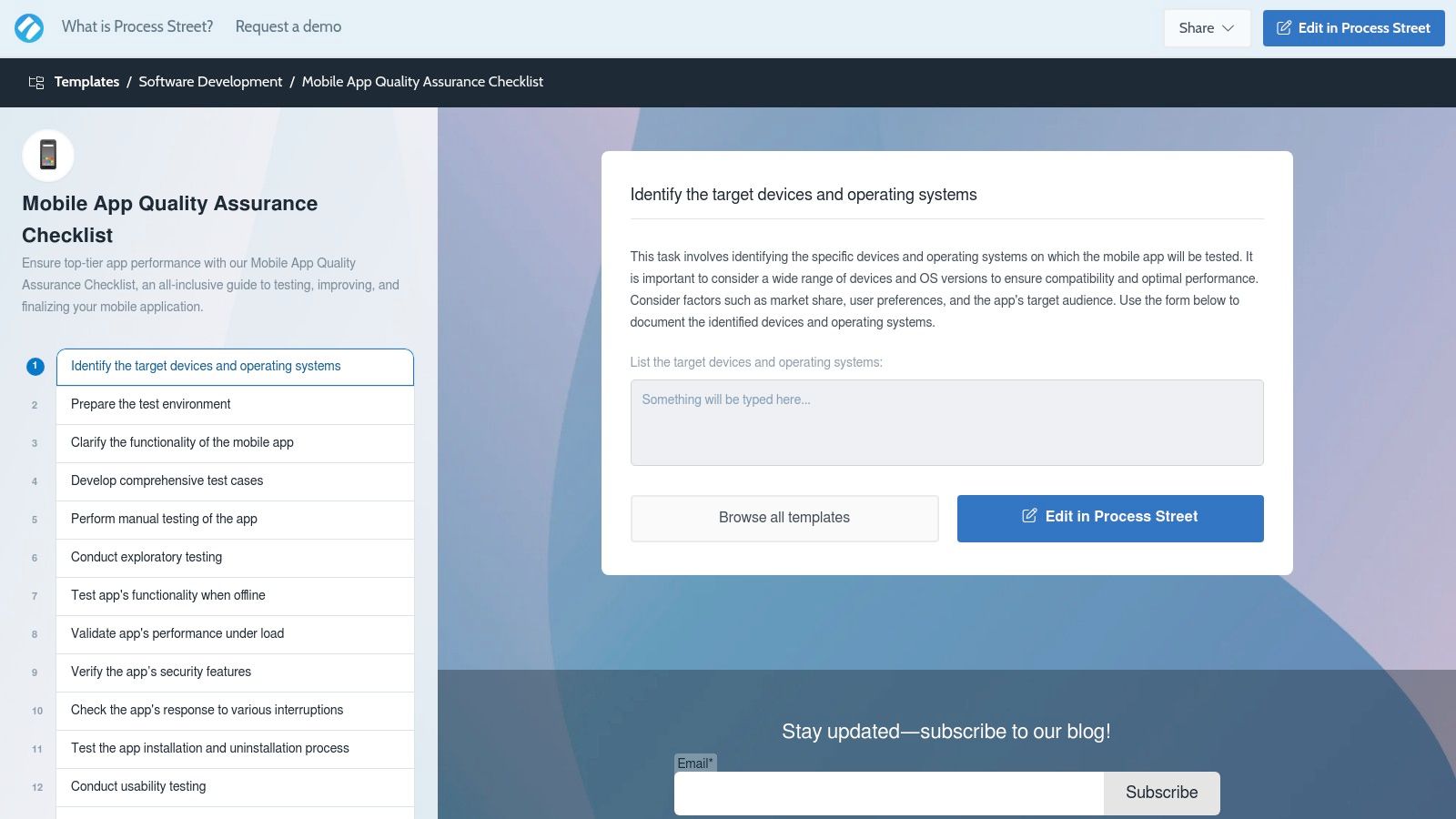
What makes Process Street unique is its focus on turning checklists into actionable, collaborative workflows. Instead of a static document, you get a dynamic process that team members can run, track, and complete. This is ideal for NextNative developers who need to ensure every build, big or small, goes through the exact same rigorous quality checks, eliminating human error and creating a consistent, auditable trail of your testing efforts.
Key Features and User Experience#
The platform is built around the idea of process management, and its user interface reflects this with clear, step-by-step layouts and powerful automation features. While you can use their pre-built template, its true power is unlocked when you customize it to fit your team's specific needs.
- Workflow Automation: You can add conditional logic, dynamic due dates, and task assignments to your checklists, turning them into automated processes. For example, a failed security check could automatically assign a task to a security engineer.
- Team Collaboration: Multiple team members can work on a checklist run simultaneously, with clear visibility into who is responsible for what. This is perfect for coordinating between developers, QA testers, and product managers.
- Detailed Templates: The mobile app testing checklist template is incredibly thorough, covering usability, compatibility, performance, and security testing in granular detail.
- Process Standardization: It helps you create a single source of truth for how testing should be done, ensuring quality and consistency across all your projects.
Pro Tip: Use the "Stop Tasks" feature in Process Street to create hard gates in your QA process. For instance, you can set a mandatory approval step after security testing that prevents the workflow from proceeding to the deployment phase until a senior developer or security lead has signed off. This enforces critical mobile development best practices directly within your workflow.
Pros and Cons#
| Pros | Cons |
|---|---|
| ✅ Powerful workflow and process management features. | ❌ Advanced automation features require a subscription. |
| ✅ Excellent for team collaboration and standardization. | ❌ Can feel like overkill for very small, simple projects. |
| ✅ User-friendly interface for managing complex checklists. |
Ultimately, Process Street is the perfect choice for teams looking to move beyond simple checklists and build a scalable, repeatable, and robust quality assurance system. It excels at making your mobile app testing checklist a living, automated process that drives efficiency and quality.
Website: Process Street Mobile App Quality Assurance Checklist
6. Space-O Technologies: The Comprehensive QA Blueprint#
For teams that believe "thorough" is an understatement, Space-O Technologies offers a masterclass in detail with its exhaustive mobile app testing checklist. This resource is less of a simple list and more of a complete QA blueprint, featuring a staggering 183 distinct checkpoints. It’s designed for developers who want to leave no stone unturned, covering everything from core functionality to the nuanced aspects of user experience and accessibility.
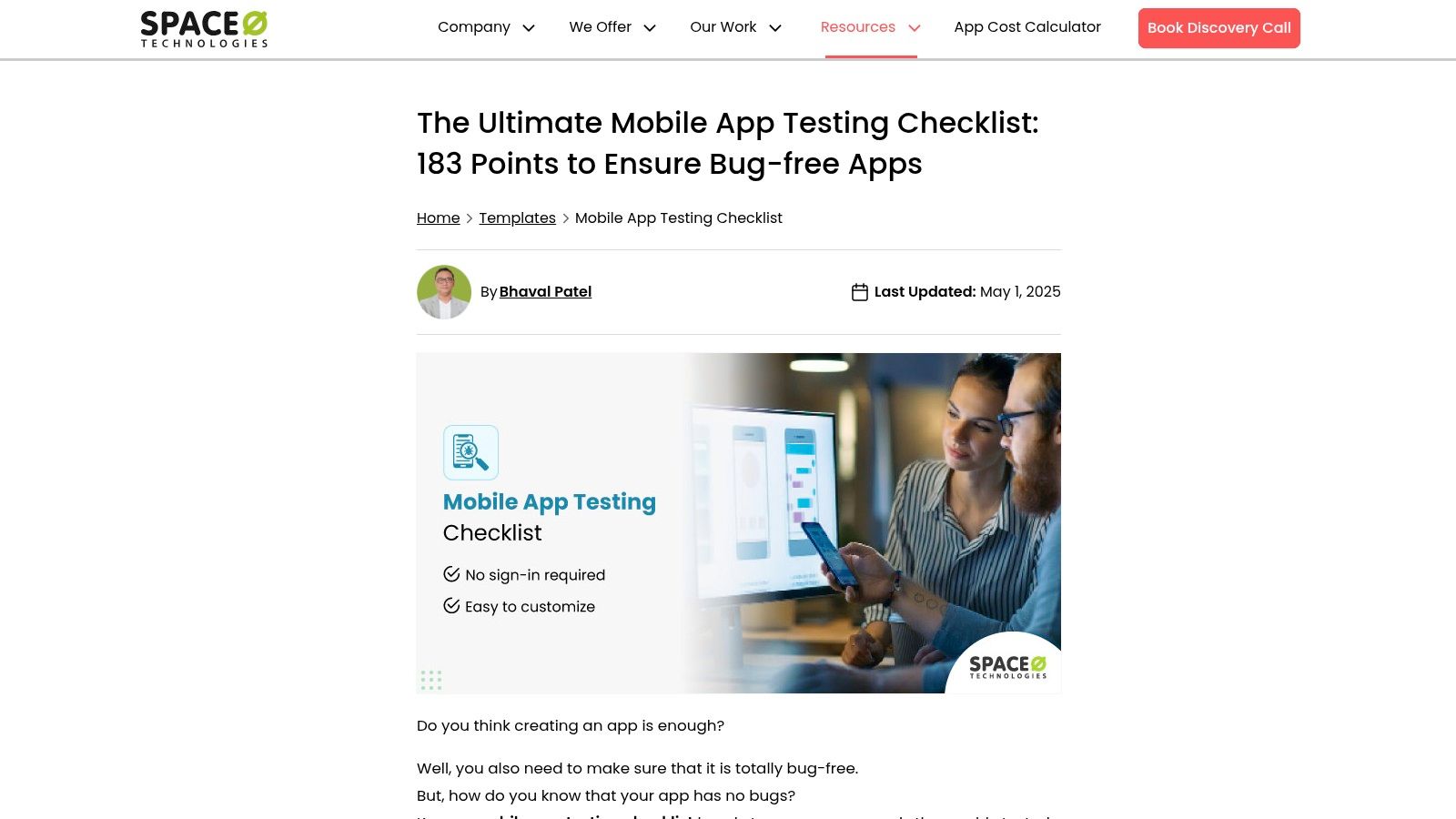
What sets Space-O Technologies apart is its dual nature as both a resource provider and a service-based agency. While the checklist itself is a powerful, free tool, the platform also serves as a gateway to professional QA and development services. This is particularly useful for NextNative developers who may build a fantastic app but prefer to outsource the rigorous, time-consuming testing phase to a specialized team. The checklist provides the framework, and their team offers the execution.
Key Features and User Experience#
The checklist is presented in a clean, article-style format on their website, which is easy to read and navigate. The ability to download the entire checklist makes it a practical tool for offline use or for integration into your own internal documentation.
- Massive Detail: With 183 points, this checklist is one of the most comprehensive available for free. It covers configuration, UI/UX, performance, security, and crucial cross-platform compatibility tests.
- Downloadable for Offline Use: Users can download the full checklist, allowing them to work with it in environments without internet access or to adapt it into their own project management systems manually.
- Gateway to Professional Services: The platform provides a clear path for teams needing more than just a list. You can easily inquire about their full-suite QA testing and app development services.
- Accessibility Focus: It includes dedicated sections for accessibility testing, an area that is often overlooked but is critical for creating inclusive applications.
Pro Tip: Use the downloadable version of this mobile app testing checklist as a foundation to create a master QA document for your organization. You can import the 183 points into a spreadsheet and add columns for "Assigned Tester," "Status," and "Notes." This turns a static list into a living document for tracking your entire testing effort across multiple projects.
Pros and Cons#
| Pros | Cons |
|---|---|
| ✅ Extremely comprehensive with 183 detailed test points. | ❌ Lacks direct integration with project management tools. |
| ✅ Free and downloadable for convenient offline use. | ❌ Professional services require a significant investment. |
| ✅ Provides a clear path to expert QA and dev support. | |
| ✅ Strong focus on often-neglected areas like accessibility. |
Space-O Technologies is an ideal resource for NextNative developers and teams who prioritize depth and completeness in their quality assurance process. It’s perfect for final pre-launch checks or for establishing a high-standard internal QA protocol. While it requires manual integration into your workflow, the sheer breadth of its coverage ensures your app is tested from every conceivable angle.
Website: Space-O Technologies Mobile App Testing Checklist
7. LambdaTest: The All-in-One Cloud Testing Platform#
LambdaTest stands out by pairing a comprehensive mobile app testing checklist with a powerful cloud-based testing platform. This isn't just a list of what to test; it's an integrated ecosystem where you can immediately execute those tests. The checklist itself is a detailed blog post covering critical areas like functionality, compatibility across devices, security vulnerabilities, performance benchmarks, accessibility standards, and localization, providing a solid theoretical foundation for your QA strategy.
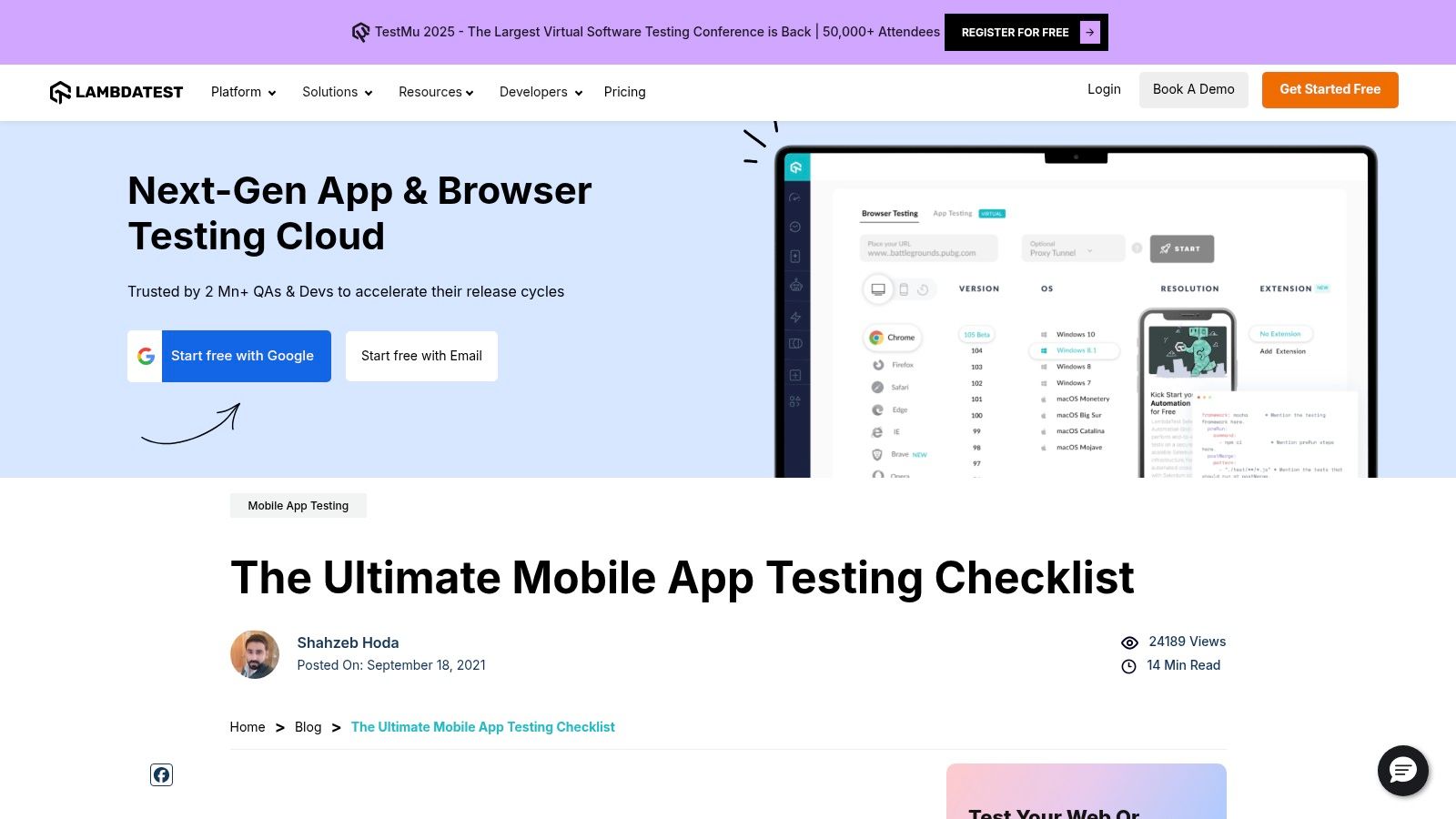
The platform's true power lies in its execution capabilities. LambdaTest offers NextNative developers access to an online device farm with thousands of real mobile devices, emulators, and simulators. This allows you to move directly from reviewing a checklist item, like "Test on older Android versions," to spinning up a real device with that exact OS and running your tests instantly, whether manually or through automated scripts. This seamless transition from planning to action makes it an indispensable tool for ensuring broad device compatibility.
Key Features and User Experience#
LambdaTest provides a unified dashboard that, while feature-rich, is designed to streamline complex testing workflows. You can easily switch between live interactive testing, running automated test suites, and reviewing results.
- Real Device Cloud: Test your app on a massive grid of real iOS and Android devices to uncover hardware-specific bugs you'd miss on emulators alone.
- Manual and Automated Testing: Supports both live, interactive testing for exploratory QA and integration with automation frameworks like Appium, Espresso, and XCUITest for scalable regression testing.
- Comprehensive Checklist Resource: The accompanying blog post serves as an excellent educational tool, ensuring your testing plan covers all essential bases from UI to backend performance.
- Focus on User Experience: The checklist and platform tools emphasize testing for smooth navigation, responsiveness, and overall user satisfaction, which is crucial for app store success.
Pro Tip: Use LambdaTest’s real device cloud to validate your app's behavior under various network conditions (e.g., 3G, 4G, spotty Wi-Fi). This helps ensure a positive user experience even for users with poor connectivity. Testing these scenarios is also vital for meeting the high standards detailed in the app store review guidelines.
Pros and Cons#
| Pros | Cons |
|---|---|
| ✅ Wide range of device and environment testing options. | ❌ Some advanced platform features require paid subscriptions. |
| ✅ Access to powerful cloud infrastructure for scalable testing. | ❌ The sheer number of options can be overwhelming for beginners. |
| ✅ Supports both manual and automated testing workflows. |
Ultimately, LambdaTest is more than just a resource for a mobile app testing checklist; it’s a full-fledged testing environment. It is ideal for NextNative teams that need to validate their application across a wide spectrum of real-world conditions, devices, and operating systems, ensuring a robust and polished final product.
Website: LambdaTest Mobile App Testing Checklist
Mobile App Testing Checklist Comparison#
| Item | Implementation Complexity 🔄 | Resource Requirements ⚡ | Expected Outcomes 📊 | Ideal Use Cases 💡 | Key Advantages ⭐ |
|---|---|---|---|---|---|
| Your Checklists | Low - predefined checklists, no customization | Minimal - free access, no advanced tools needed | Effective coverage of key testing areas | Quick checklist reference, basic app testing | Free, user-friendly, integrates with PM tools |
| BrowserStack | Medium - manual and automated testing on real devices | High - real device access, automation setup | High accuracy and thorough testing on real platforms | Comprehensive cross-platform testing | Real devices, automation, detailed checklist |
| Ubertesters | Medium - requires platform signup, test management | Medium - beta testing tools, bug reporting | Detailed testing with collaboration and QA workflows | Beta testing, bug tracking, collaborative QA | Downloadable checklist, team collaboration tools |
| QAwerk | Medium to High - checklist plus professional QA services | High - access to expert manual and automated QA | High quality assurance before launch | Professional QA support, early issue detection | Expert QA services, detailed multi-stage testing |
| Process Street | Medium - checklist plus workflow/process management | Medium - platform subscription for advanced use | Improved team efficiency and standardized QA process | Team collaboration, process automation | Workflow management, team collaboration |
| Space-O Technologies | High - very extensive checklist & QA/development services | High - professional QA and development support | Comprehensive, in-depth testing coverage | Enterprise-level QA, extensive testing needs | 183-point checklist, professional consultancy |
| LambdaTest | Medium - cloud-based manual & automated testing | High - cloud infrastructure, device/emulator access | Reliable testing across devices and environments | Cloud-based testing, diverse device coverage | Cloud testing, emulators, manual & automated |
Integrating Your Checklist for a Perfect NextNative Launch#
Whew, we've covered a lot of ground! From downloadable PDF guides to powerful, cloud-based testing platforms, it’s clear that a one-size-fits-all approach to mobile app testing doesn't exist. The journey from a promising Next.js project to a polished NextNative application in the app store is paved with meticulous quality assurance. The resources we've explored, including BrowserStack, Ubertesters, QAwerk, and LambdaTest, aren't just lists of tasks; they are strategic frameworks designed to catch bugs before your users do.
A comprehensive mobile app testing checklist is more than a pre-launch formality. It’s a dynamic roadmap that guides your development lifecycle, ensuring that every feature, from push notifications to offline functionality, works flawlessly across the diverse landscape of mobile devices. For NextNative developers, this process is especially crucial. You're leveraging the speed of web development for native performance, and a disciplined testing process ensures that this advantage isn't lost to post-launch hotfixes and negative reviews.
From Checklist to Action: Making It Work for You#
Merely possessing a checklist isn't enough; the real magic happens in its integration. The tools and services we've discussed each offer a unique pathway to QA excellence. Your task is to select and combine them in a way that perfectly complements your workflow, budget, and team structure.
Let's break down how to build your custom testing stack:
- For the Solo Founder or Small Team: Simplicity and efficiency are your best friends. Start with a foundational guide like the one from Space-O Technologies to understand all the moving parts. Then, digitize that knowledge using a tool like Process Street. This transforms a static document into an interactive, repeatable workflow that you can manage without a dedicated QA team.
- For the Growing Startup: As your team and app complexity expand, you need collaboration and real-world validation. This is where platforms like Ubertesters shine, offering beta testing management and in-the-wild feedback. You can pair this with a cloud testing service like BrowserStack or LambdaTest to run automated and manual tests on a massive array of real devices, ensuring your NextNative app performs consistently for every user, everywhere.
- For the Established Agency: Your focus is on repeatability, reliability, and client satisfaction. A hybrid approach works best. Use a service like QAwerk for a comprehensive, expert-led audit to catch deep-seated issues your internal team might miss. Simultaneously, empower your developers with direct access to a platform like LambdaTest for rapid, day-to-day testing and debugging. This dual strategy ensures both high-level quality and agile development speed.
Key Takeaways for Your NextNative Launch#
Remember, the goal is to make quality assurance a continuous, integrated part of your development culture, not a final, dreaded gatekeeper.
Key Insight: Don't treat your mobile app testing checklist as a rigid set of rules. Think of it as a living document. Adapt it, customize it, and let it evolve with every new feature you build and every piece of user feedback you receive.
As you move forward, keep these final thoughts in mind:
- Start Early, Test Often: Integrate testing from the very first sprint. The cost of fixing a bug skyrockets the closer it gets to production.
- Combine and Conquer: No single tool does it all. A powerful strategy often involves using a checklist manager (like Process Street), a real-device cloud (like BrowserStack), and a beta testing platform (like Ubertesters) in concert.
- Prioritize Based on Risk: You can't test everything with the same level of intensity. Use your checklist to identify high-risk areas, like payment gateways or core user flows, and dedicate the majority of your resources there.
By thoughtfully selecting and integrating the right resources, you transform your mobile app testing checklist from a simple to-do list into your most powerful strategic asset. It’s the final, crucial step that ensures your NextNative application not only launches but thrives, delivering the seamless, high-performance experience your users expect and deserve. You've done the hard work of building a fantastic app; now, give it the launch it's earned.
Ready to turn your Next.js project into a high-performance native app that's easy to test and deploy? With NextNative, you can leverage the skills you already have to build for iOS and Android, radically simplifying the development process. Stop juggling multiple codebases and start building faster with our production-ready boilerplate.
Explore more
- How to Convert Your Next.js App to iOS & Android
- How to Add Push Notifications to Your Next.js Mobile App
- How to Add In-App Purchases to Your Next.js App
- How to Build an iOS App with Next.js in 2025
- How to Deploy Your Next.js App to the App Store
- Next.js vs React Native
- Capacitor vs React Native
- Capacitor vs Flutter
- Capacitor vs Ionic
- Next.js vs Expo
- PWA vs Native App